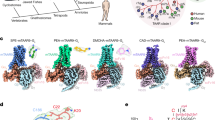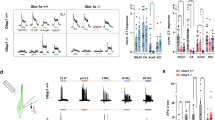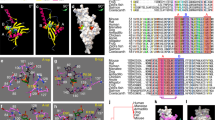Abstract
ODORANT stimulation leads to a depolarization of olfactory receptor neurons1–3. A mechanism underlying this transduction, which occurs in the sensory cilia3–6, involves a G-protein-mediated increase in adenylyl cyclase activity7–10, and therefore a rise in internal cyclic AMP and consequent opening of a cAMP-gated cation channel on the plasma membrane11–22. Another mechanism, not as well established, involves the opening of an inositol trisphosphate-activated cation channel on the plasma membrane23 as a result of phospholipase C activity24,25. In both cases, an influx of cations is thought to generate the depolarizing receptor potential. We now report, however, that the mechanism is actually more complex. The odorant-induced current appears to contain an inward chloride component also, which is triggered by calcium influx through the cation-selective channel. This newly found chloride component can be as large as the cationic component. The co-existence of cationic and chloride components in the odorant response, possibly unique among sensory transduction mechanisms, may serve to reduce variations in the transduction current resulting from changes in external ionic concentrations around the olfactory cilia. Our finding can explain the longstanding puzzle of why removal of most mucosal cations still does not diminish the amplitude of the olfactory receptor cell response26–28.
This is a preview of subscription content, access via your institution
Access options
Subscribe to this journal
Receive 51 print issues and online access
$199.00 per year
only $3.90 per issue
Buy this article
- Purchase on Springer Link
- Instant access to full article PDF
Prices may be subject to local taxes which are calculated during checkout
Similar content being viewed by others
References
Getchell, T. V. Physiol. Rev. 66, 772–818 (1986).
Firestein, S. & Werblin, F. Science 244, 79–82 (1989).
Kurahashi, T. J. Physiol. 419, 177–192 (1989).
Firestein, S., Shepherd, G. M. & Werblin, F. S. J. Physiol. 430, 135–158 (1990).
Lowe, G. & Gold, G. H. J. Physiol. 442, 147–168 (1991).
Dionne, V. E. J. gen. Physiol. 99, 415–433 (1992).
Lancet, D. A. Rev. Neurosci. 9, 329–355 (1986).
Bakalyar, H. A. & Reed, R. R. Science 250, 1403–1406 (1990).
Sklar, P. B., Anholt, R. R. H. & Snyder, S. H. J. biol. Chem. 261, 15538–15543 (1986).
Lowe, G., Nakamura, T. & Gold, G. H. Proc. natn. Acad. Sci. U.S.A. 86, 5641–5645 (1989).
Nakamura, T. & Gold, G. H. Nature 325, 442–444 (1987).
Suzuki, N. in Chemical Senses Vol. 1 (eds Brand, J. G., Teeter, J. H., Cagan, R. H. & Kare, M. R.) 469–493 (Dekker, New York, 1989).
Kolesnikov, S. S., Zhainazarov, A. B. & Kosolapov, A. V. FEBS Lett. 266, 96–98 (1990).
Kurahashi, T. J. Physiol. 430, 355–371 (1990).
Kleene, S. J. & Gesteland, R. C. J. membr. Biol. 120, 75–81 (1991).
Firestein, S., Darrow, B. & Shepherd, G. M. Neuron 6, 825–835 (1991).
Firestein, S., Zufall, F. & Shepherd, G. M. J. Neurosci. 11, 3565–3572 (1991).
Kurahashi, T. & Kaneko, A. NeuroReport 2, 5–8 (1991).
Zufall, F., Firestein, S. & Shepherd, G. M. J. Neurosci. 11, 3573–3580 (1991).
Frings, S., & Lindemann, B. J. gen. Physiol. 97, 1–16 (1991).
Frings, S., Lynch, J. W. & Lindemann, B. J. gen. Physiol. 100, 45–67 (1992).
Kramer, R. H. & Siegelbaum, S. A. Neuron 9, 897–906 (1992).
Restrepo, D., Miyamoto, T., Bryant, B. P. & Teeter, J. H. Science 249, 1166–1168 (1990).
Huque, T. & Bruch, R. C. Biochem. biophys. Res. Commun. 137, 36–42 (1986).
Boekhoff, I., Tareilus, E., Strotmann, J. & Breer, H. EMBO J. 9, 2453–2458 (1990).
Tucker, D. & Shibuya, T. Cold Spring Harbor Symp. quant Biol. 30, 207–215 (1965).
Suzuki, N. Comp. Biochem. Physiol. 61A, 461–467 (1978).
Yoshii, K. & Kurihara, K. Brain Res. 274, 239–248 (1983).
Kurahashi, T. & Shibuya, T. Brain Res. 515, 261–268 (1990).
Kleene, S. J. & Gesteland, R. C. J. Neurosci. 11, 3624–3629 (1991).
Horn, R. & Marty, A. J. gen. Physiol. 92, 145–159 (1988).
Yamashita, M. & Wässle, H. Vis. Neurosci. 6, 399–401 (1991).
Alvarez-Leefmans, F. J. in Chloride Channels and Carriers in Nerve, Muscle and Glial Cells (eds Alvarez-Leefmans, F. J. & Russell, J. M.) 109–158 (Plenum, New York, 1990).
Author information
Authors and Affiliations
Rights and permissions
About this article
Cite this article
Kurahashi, T., Yau, KW. Co-existence of cationic and chloride components in odorant-induced current of vertebrate olfactory receptor cells. Nature 363, 71–74 (1993). https://doi.org/10.1038/363071a0
Received:
Accepted:
Issue Date:
DOI: https://doi.org/10.1038/363071a0
This article is cited by
-
The cyclic AMP signaling pathway in the rodent main olfactory system
Cell and Tissue Research (2021)
-
A dominant variant in the PDE1C gene is associated with nonsyndromic hearing loss
Human Genetics (2018)
-
Single Ca2+-activated Cl− channel currents recorded from toad olfactory cilia
BMC Neuroscience (2016)
-
Cnga2 Knockout Mice Display Alzheimer’s-Like Behavior Abnormities and Pathological Changes
Molecular Neurobiology (2016)
-
Expression of calcium-activated chloride channels Ano1 and Ano2 in mouse taste cells
Pflügers Archiv - European Journal of Physiology (2016)
Comments
By submitting a comment you agree to abide by our Terms and Community Guidelines. If you find something abusive or that does not comply with our terms or guidelines please flag it as inappropriate.



